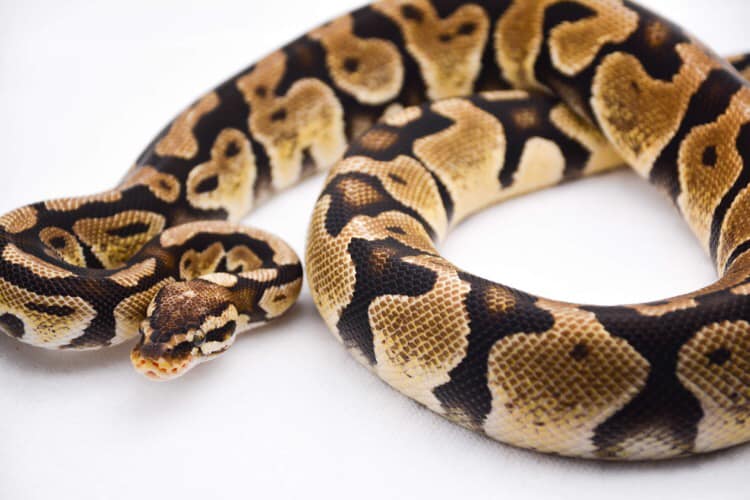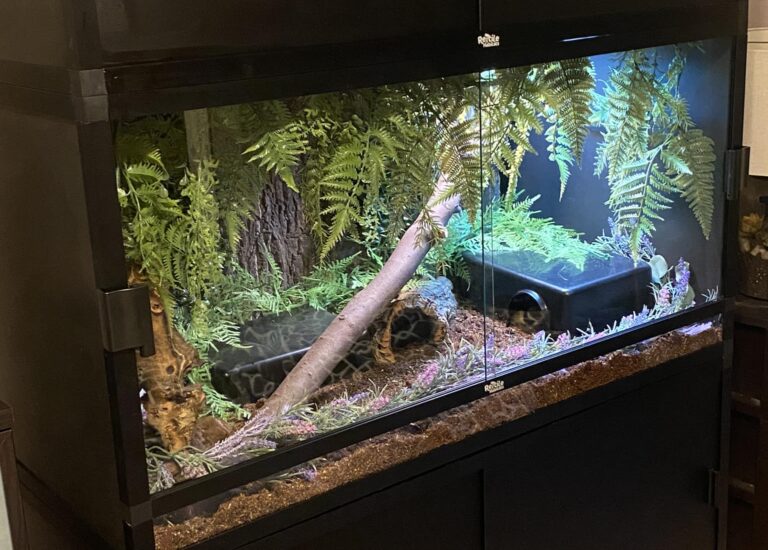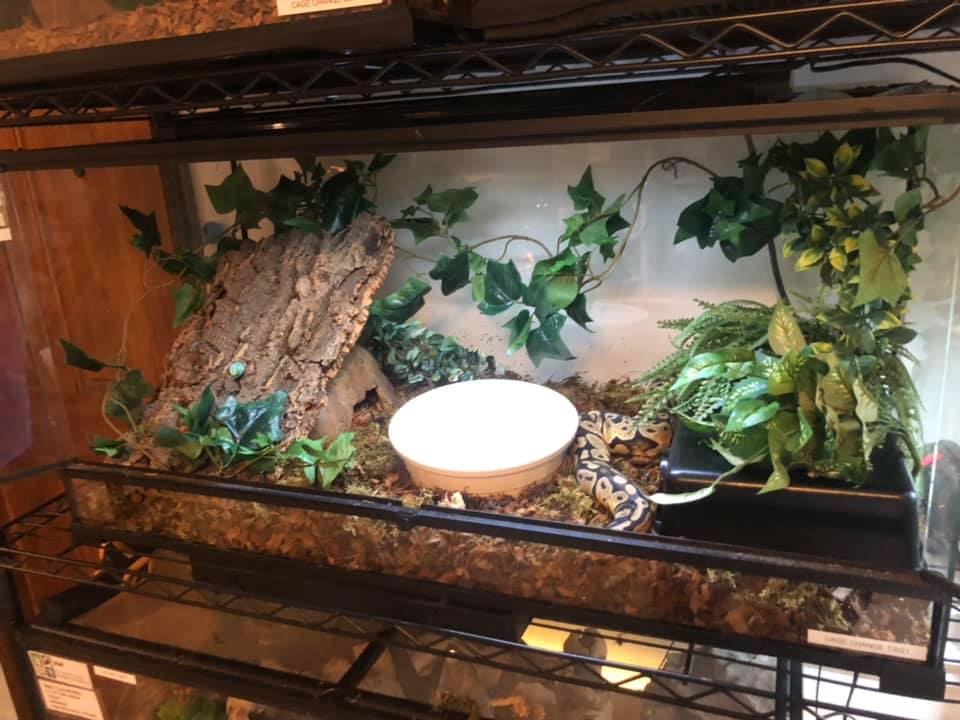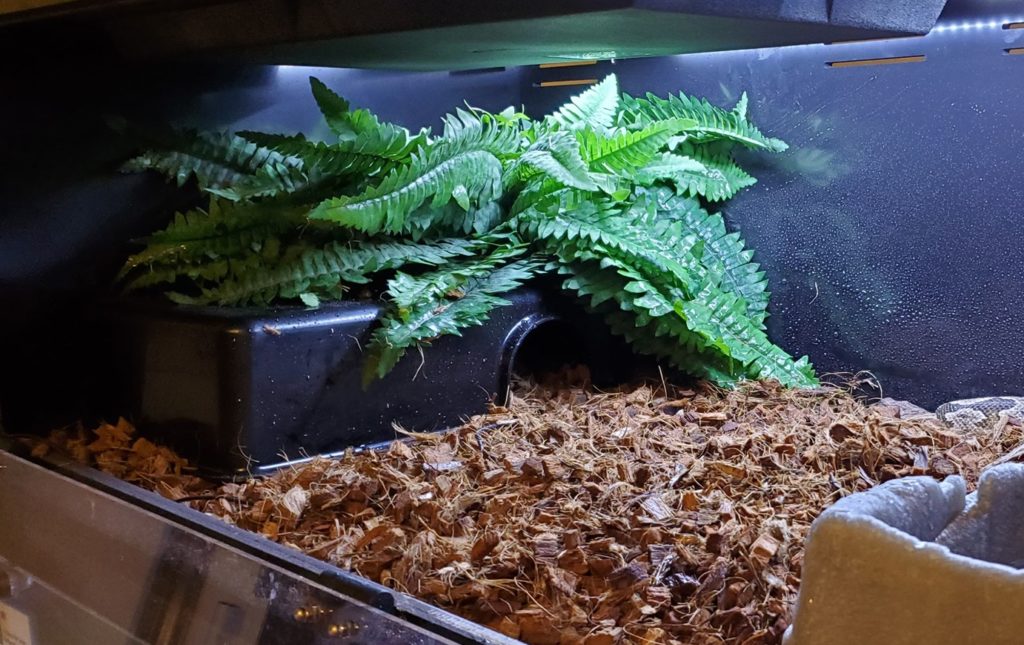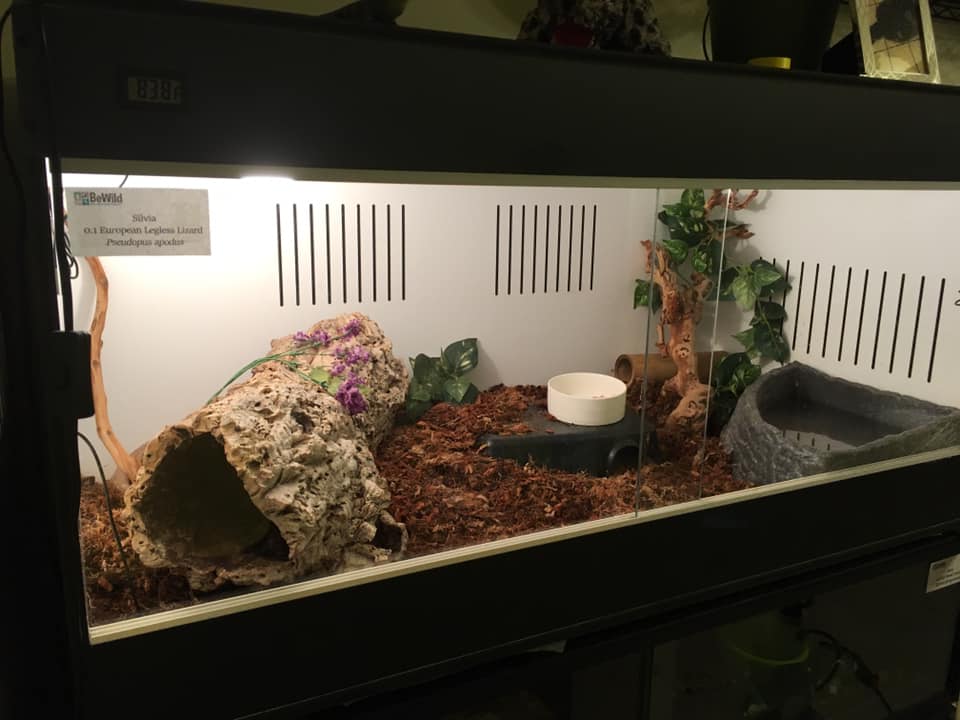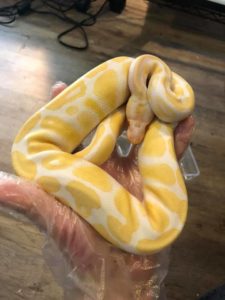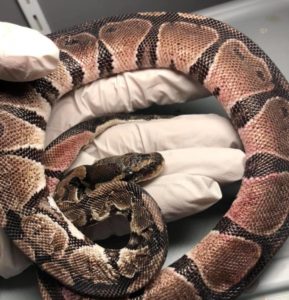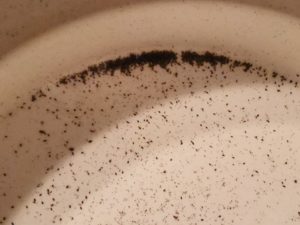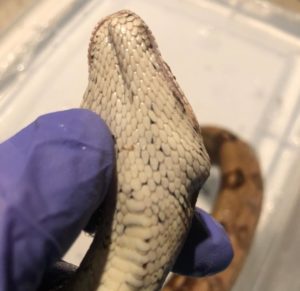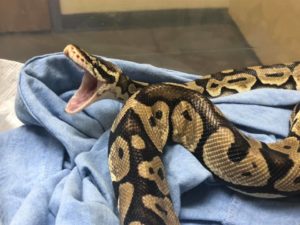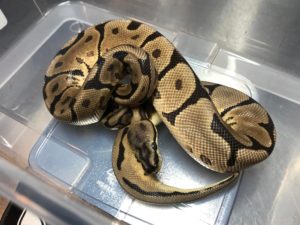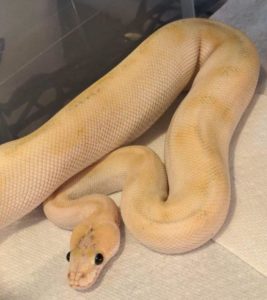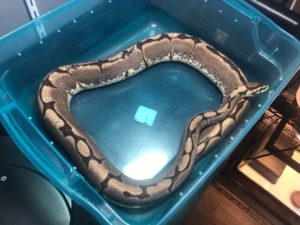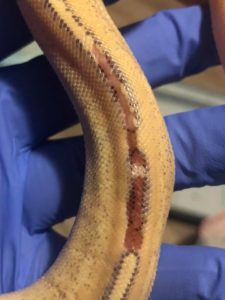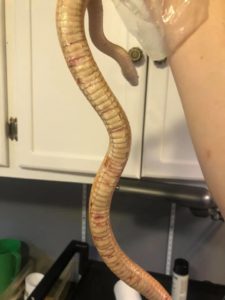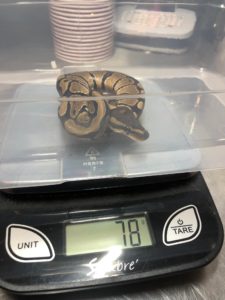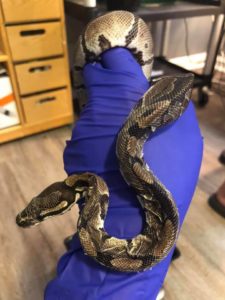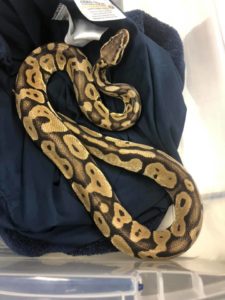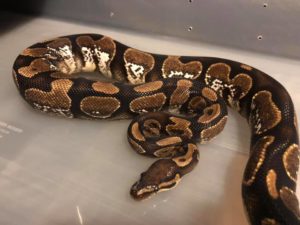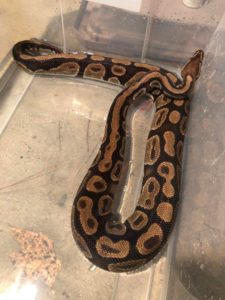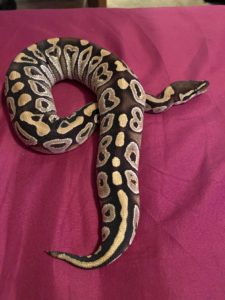BALL PYTHON CARE GUIDE
Species name: Python regius
Lifespan: 20-30 years
Origin: Central Africa
Adult size: 3-5 feet
Caging
Enclosures are a controversial topic in the ball python world, but many types are acceptable as long as your ball python is eating regularly, shedding well, and not exhibiting stress behaviors. There is individual preference as well! Some ball pythons are more bold and will do fine in larger, more exposed enclosures. Other ball pythons are very shy and might need smaller, darker, or more cluttered enclosures to feel secure. Our minimum recommended size for an adult ball python is a 36” x 18” x 12” enclosure, but we personally prefer a 4’ x 2’ x 2’. Of course, a juvenile can be kept in a smaller enclosure and upgraded to a larger enclosure as it grows.
- PVC: Our personal favorite ball python enclosures are PVC enclosures, as they are attractive, hold humidity well, and come in many acceptable sizes. The only real downside is that they can be pricey. PVC cages work wonderfully with heat pads and radiant heat panels. If you’d like to use overhead lighting however, you can use a jigsaw to remove a small section of the top PVC panel. Simply affix hardware cloth over the removed section and you can place your dome on the hardware cloth. You can purchase PVC enclosures from websites like Reptile Basics, DIYCages, APCages, BoaMaster, and many other online sellers.
- Tanks: Tanks, or aquariums, are probably the most difficult type of enclosure to make work for a ball python. They take a lot of modification to make the snake feel secure and hold humidity appropriately. We receive many surrendered ball pythons that were kept in tanks with varying degrees of stuck shed, retained eyecaps, or dry, wrinkled scales. If you choose to use a tank for your ball python, we recommend a 40 gallon breeder minimum for an adult and would recommend going bigger if possible. You should cover up about 80-90% of the screen top with thick plastic sheeting, plexiglass, or aluminum foil tape to keep the humidity in. Use one of the substrates listed below and mist a few times a week to keep humidity at the appropriate level. If you’re having issues with low humidity in a tank, try switching to a bin instead. Some ball pythons may feel too exposed in a tank because of the transparent sides, so you may have to paint the sides or cover them up with paper or vinyl contact paper.
- Bins: DIY bin cages can work great for ball pythons, and they don’t have to be small or boring! Many stores sell translucent 50 gallon bins that are a great size for adults and bins can allow for proper space and enrichment. Drill or melt holes in the lid or sides for ventilation, and make sure that the enclosure has latches and that the lid is secure. Test the lid with your fingers to make sure it is rigid and a snake can’t push it open. Not all brands are secure enough for snakes. You can spruce up your bin cage with all sorts of decor and enrichment, just like a tank or PVC enclosure. We use bins for many of our snakes in rescue – they are great for nervous snakes who are not eating or for snakes with dry scales. They are safe to use with under tank heat pads as long as you use a thermostat, which is a necessity no matter what enclosure you’re using. If you’d like to use overhead lighting with your ball python, you can use a soldering pen to cut out a small section of the lid and cover it with hardware cloth.
- Racks: Racks have been used successfully by ball python keepers and breeders for many years. However, we are of the opinion that if used they should be large and enriched. Personally, we think 41 qt rack tubs should be the absolute bare minimum for an adult ball python. However, bigger is always better and there are racks with larger tubs available both commercially and custom-made! The ARS 9706 rack has 50 gallon tubs and there are even custom racks available that utilize Christmas tree bins. We also strongly prefer clear bins that allow the snake to still have a day/night light cycle. Unfortunately, racks cannot be used with overhead heating sources, so if you are planning on going that route you will need to pick another caging option. In addition, ball pythons have different personalities and preferences. While most of the ball pythons we’ve gotten in would do fine in a rack set-up, we have had some that are very active and exhibit climbing behaviors. If you observe these types of behaviors in your ball python, you should consider using a style of cage with more height.
Decor
The most important piece of decor for a ball python is a good hide! Choose a hide that has one small opening so that the snake can feel secure and hidden. We like the plain black plastic hides from Pangea, but other more naturalistic hides work as well. Offer your snake at least 2 hides, one on each side of the enclosure. Other good enrichment items include cork bark, branches, and foliage to hide in.
Substrate
For ball pythons, we recommend a substrate that can hold humidity well and not mold. Our personal favorite is ReptiChip and other similar coconut bark products like ProCoco. Cypress mulch is another good choice as long as it is well-sourced and mite-free. We often like to do substrate mixes for our pythons that include ReptiChip, cypress mulch, coconut coir, and sphagnum moss. If you decide to keep your ball python in a bioactive enclosure, you’ll want to use a bioactive substrate like Josh’s Frog ABG mix or a DIY mixture of organic topsoil, coconut coir, and sphagnum moss. We typically use 2-3” of substrate, though if your snake loves burrowing you can definitely offer deeper substrate.
For an animal in quarantine, we recommend keeping them on newspaper or paper towels so that you can easily monitor them for internal and external parasites. Non-particulate substrates should also be used if the snake is sick or has injuries, as you want to keep the wound clean and prevent reinfection.
Humidity/Water
Provide your snake with a water dish large enough to soak in. Make sure the water and dish stay clean. Aim for a humidity level of 60%. Please note that not all hygrometers are accurate and you should be assessing for correct humidity by the condition of your ball python’s scales and sheds.
Heating
Several different heat sources can be used for ball pythons. We recommend a hot spot of 88-90°F and a cool side of 72-80°F. We’ve listed a few of the commonly used options below:
- Heat Pads: We personally favor using under tank heat pads controlled by reptile thermostats. These are safe to use and keep the hot spot at a consistent temperature. We have NEVER had an issue with burns from regulated heat pads. They also do not dry out the air and don’t give off any bright lights, which may make some ball pythons more stressed. We’ve had great success using regulated heat pads to rehab ball pythons that are refusing to eat or suffering from chronic dysecdysis.
- Radiant Heat Panels/CHEs/DHPs: Overhead heating elements, such as radiant heat panels, ceramic heat emitters, and deep heat projectors may also be used. These produce heat, but do not emit light. Radiant heat panels do a good job of dispersing heat inside larger PVC cages. All of these options can be used at night without interrupting the animal’s day/night cycle.
- Incandescent/Halogen Lighting: Some ball python keepers strongly recommend providing heat with a halogen light as they have been shown to most closely replicate the sun by providing IR-A, IR-B, and IR-C. The most commonly recommended lights are PAR30, PAR36, or PAR38 outdoor halogen flood lamps. We personally have not seen conclusive evidence that these lamps are more beneficial to reptiles or improve their overall health. We do believe this to be a viable husbandry option, however, and many keepers are able to keep ball pythons successfully using these lamps. Strong overhead lighting can dry out the enclosure and may be stressful for some snakes. However, these issues can be rectified. To keep your humidity levels high enough, mist more frequently and carefully monitor the humidity levels using a hygrometer and by checking your snake’s sheds. You can purchase inexpensive digital hygrometers for this purpose. Just be aware that “stick-on” hygrometers are typically very inaccurate. Also be careful to ensure that the snake cannot touch the bulb itself, as they are capable of causing burns.
- Reptile-Branded Basking Bulbs: Reptile-branded basking bulbs can also be used, but we find that they have the same downsides as halogen flood lamps without many of the reported benefits. They’re also typically overpriced!
- Night-Time Heating: If a heat pad, radiant heat panel, or ceramic heat emitter are being used, these can be used at night without disturbing the animal’s sleep cycle and no additional night-time heat is needed. If overhead lights are being used as the primary heating source, they should be turned off at night. A temperature drop at night time is fine and is actually believed to be beneficial, however you also want to avoid the temperature regularly dropping below 75°F. Alternatively, you can also set-up a ceramic heat emitter to turn on only at night.
Lighting
Lighting is also a controversial topic amongst keepers, as many don’t think lighting is necessary at all. We’ll go through a few different types of lighting and our recommendations.
- Ambient: We personally believe all snakes should have access to a day/night cycle. If you are not using an overhead basking bulb, make sure to provide ambient lighting in the room with an appropriate light cycle. It’s for this reason that we don’t recommend solid-colored bins or tubs.
- Basking Bulbs: See the information above regarding basking bulbs.
- Enclosure Viewing: If the lighting is just for enclosure viewing, you can use low wattage incandescent lighting or LED lighting, which don’t give off much heat.
- UVB Lighting: There is currently no firm evidence that UVB lighting is necessary for ball pythons, and the majority of ball python keepers do not use UVB lighting. Most carnivorous animals, such as snakes with whole-prey diets, obtain vitamin D from their prey items and do not need UVB light to convert it dietarily. While there is evidence that UVB will increase the vitamin D level in their blood, there is not a published standard of the normal vitamin D values that are necessary for bodily function. Essentially, it is largely unproven that they benefit from higher vitamin D levels or that these higher levels contribute to a greater quality of life. However, some keepers strongly believe it to be beneficial and there is certainly no harm in offering it as long as you provide foliage and cover for them to utilize as desired. If you choose to provide a UVB light, we recommend a lower UVB percentage such as a 5% bulb. The Arcadia ShadeDweller is a popular choice.
Diet
Ball pythons primarily eat rodents, such as mice and rats. We feed prey items that are about as big as the largest part of the body, so the diet will change as your snake grows. Hatchling ball pythons can eat small mice or pinkie rats, while adult ball pythons can eat small to large rats. We feed hatchling and juvenile ball pythons once every 7 days, and full grown adult ball pythons every 10-14 days. An overweight adult ball python might be fed every 21-28 days, but only if weight loss is necessary. You can also offer chicks or quail to diversify their diet.
We do recommend feeding frozen/thawed meals to all snakes that will take them. We have received many surrendered snakes with moderate to severe scarring from rodent bites. Frozen/thawed is cheaper, easier to maintain, safer for the snake, and more humane for the rodent. You can purchase frozen rodents online from many different feeder rodent suppliers. Many snakes come to us with their owners saying they only eat live, but we have only ever had 2 snakes out of hundreds that refused to switch over to F/T. If you do find yourself in a situation where you must feed live, never leave the rodent with your snake unattended. Feeder rodents WILL fight back, and can end up giving your snake some severe, potentially lethal wounds if not monitored.
Things You Should NOT Do
Use aspen, pine, or cedar shavings: We don’t recommend wood shavings in general as they easily mold when in a higher-humidity setup. Aspen is safe for lower-humidity snakes, but pine or cedar should never be used due to toxic phenols in the wood.
Use a red heat lamp: Reptiles CAN see red light and this will disturb their sleeping cycles. If you need additional heat at night, use a ceramic heat emitter or just switch to a heat pad entirely.
Use a heat rock: While many pet stores will try to sell you a heat rock, they are extremely dangerous. Do not use them for any animal. Heat rocks are not well regulated and can reach temperatures high enough to severely burn your animal.
Cohabitate: Ball pythons are not social animals and should never be housed with another snake. They can, and often will, show aggression towards each other. There are several cases of cannibalism with ball pythons and it is not worth the risk.
Common Health Issues
Burns: Ball pythons can become burned by heat rocks or unregulated heat pads. NEVER use heat rocks at all, as they cannot be regulated. They have caused severe injuries – we’ve seen some ourselves. All under-tank heat pads should be controlled by a thermostat. If your snake has blisters, ulcerations, or reddened ventral scales, then it could have suffered a burn. Visit a veterinarian to assess the severity, where they may prescribe topical antiseptics or antimicrobial creams. Silver sulfadiazine cream is great for burns in general.
Cryptosporidium: This is a serious parasitic disorder that cannot be completely eradicated with traditional antiparasitic medications. Signs include regurgitation, weight loss, and midbody swelling due to hypertrophy of the stomach or small intestine. Cryptosporidium is difficult to diagnose because the oocysts are much smaller than other parasites. For the best diagnosis, we recommend sending off a fecal sample to a testing lab for PCR analysis. You may need to send off several fecals if you are suspicious of crypto, as they do not always shed oocysts. This is a very contagious parasite and you should test all potentially infected snakes in the same area. Veterinarians will typically recommend humane euthanasia, and all enclosures, tools, and decor that have come in contact with the snake should be disposed of.
Dysecdysis/Retained Shed: Ball pythons often have issues with stuck shed, as they need higher humidity than our ambient indoor humidity levels. A ball python should finish shedding in about one hour and a good shed should be in one intact piece. Always make sure that they shed their eye caps and the tips of their tails. If they have retained shed, soak the snake in a shallow bin of warm water and gently remove the shed with a cotton swab. However, NEVER force shed off a snake unless it easily rolls off. This can cause serious scale damage. If the shed is not coming off with gentle stroking, heavily mist your snake’s enclosure, offer a humid hide of sphagnum moss, and soak daily until it is removed. If your snake is having chronic issues with retained shed, or if there is infection and necrosis, see a veterinarian and immediately correct your humidity issues by modifying your tank, switching to your bin, or providing a humid hide.
Hypovitaminosis C: This is a rare condition in ball pythons, as usually they obtain most of their vitamin C from their diet. However, if the snake is anorexic, has not eaten in a long time, or is being fed rodents with diets low in vitamin C, then they can develop a deficiency. In humans, this is called “scurvy.” Signs include thin, translucent skin that tears easily, and fluid buildup, or edema, may develop under the skin especially in the back third of the body. If you think your snake may have hypovitaminosis C, see a veterinarian for vitamin supplements and nutritional support.
Inclusion Body Disorder (Reptile Arenavirus): This is a rare viral disease that is spread between snakes and usually affects boas and pythons. The most common symptoms include regurgitation, weight loss, and neurological issues such as “stargazing”, discoordination, sitting upside down, or failure to right themselves. Respiratory infections and mouth rot may also be present. If you think your snake may have IBD, immediately seek the help of an experienced reptile veterinarian. You can send off diagnostic PCR testing and should test any other snakes housed in the same area, as it is very contagious and can infect an entire collection. While boa constrictors can have asypomatic arenavirus for years and years, pythons typically decline very quickly after contracting it. There is no effective treatment and once a snake is displaying symptoms, a veterinarian will typically recommend human euthanasia.
Mites: One of the most common external parasites in snakes is the snake mite, Ophionyssus natricis. These are fairly common in ball pythons, and one of the reasons that you should quarantine all new arrivals in sterile setups with paper towels in a separate area than your general collection. Mites are typically not fatal, though a heavy infestation in a weak or young snake can cause anemia and secondary infection, and they are thought to be potential vectors for a few viral diseases. However, mites can be very difficult to get rid of, especially in large collections or with naturalistic enclosures. Snakes with mites will often soak in their water bowl and the mites will drown and sink to the bottom of the bowl. Inspect the water bowl carefully for small black dots; if you press one against a paper towel, it will burst with red-brown blood. If your snake has mites, immediately move it into a sterile setup with a plastic water dish, a plastic hide box, and paper towels. You should toss any wood items or any items that have deep crevices and cannot be completely sanitized. The entire cage should be cleaned with bleach and rinsed thoroughly, and the snake can be soaked in a dilute betadine solution to remove most mites from the body. We recommend spraying the cage with Provent-A-Mite, a permethrin spray that is safe with ball pythons when used properly. Follow the instructions on the can and closely inspect your snake and any others close by until they are clear from mites for several weeks. We have also had good luck with fipronil sprays, but many have unfortunately been discontinued.
Mouth Rot: Mouth rot, or ulcerative stomatitis, is a condition where the mouth develops a bacterial infection. This can be due to a dirty water source or dirty enclosure, a wound in the mouth that becomes infected, or stuck shed around the face. Mouth rot can quickly become serious, as it is painful and will cause the snake to not want to eat. You should see a veterinarian, who will out the mouth with dilute chlorhexidine or betadine and start an antibiotic regimen. Make sure to always maintain a clean environment.
Nidovirus: This is a viral disease that seems to be becoming more prevalent in collections. Signs include a respiratory infection that may not respond to antibiotics and thick, stringy mucus in the mouth. Nidovirus has many different strains and can be difficult to diagnose, as infected snakes typically only shed the virus when they are stressed or otherwise sick. If you think your snake has nidovirus, we recommend sending off multiple samples for PCR testing to Research Associates Laboratory or Fishhead Laboratories. The snake should be quarantined away from any others and strict quarantine should be used. Individual snakes are affected by this virus differently. Some become gravely ill and struggle to breathe with a severe respiratory infection and should be humanely euthanized. Others have milder symptoms that may only show up when they are stressed or having other illnesses affecting them. We recommend consulting your exotics veterinarian for treatment and prognosis.
Neurological Issues: Some morphs of ball pythons, such as the spider morph, are predisposed to have neurological symptoms. Symptoms can be mild and have little effect on the snake’s quality of life, or they can be severe and heavily impact their health and comfort. Signs include a “wobbling” of the head and neck, “stargazing”, inability to accurately strike food, flipping upside down, and general discoordination. Other causes of neurological disease in snakes include exposure to toxins such as pesticides, head trauma, or exposure to extremely high temperatures.
Parasites: Snakes can carry many different types of parasites, including pinworms, coccidia, spirochetes, and protozoans. It is common for reptiles to have a small level of parasites, this is normal for their gut flora. However, when a reptile is sick or stressed, the parasites can take over and cause diarrhea, weight loss, regurgitation, and anorexia. This can become serious, so bring a fecal to your veterinarian if your ball python is exhibiting the above signs.
Prolapse: Cloacal prolapse can happen in both male and female snakes, but male snakes can also get hemipenal prolapses. A prolapse is an emergency that should see a veterinarian immediately. If it is recent, sometimes the vet can push the prolapsed tissue back in and place a temporary suture, but advanced prolapses can become infected and necrotic. Some will require amputation. Prolapses can be caused by dehydration, fecal impaction, egg laying, egg binding, or can be from no noticeable cause.
Respiratory Infection (general): Many snakes develop respiratory infections due to incorrect temperatures, humidity, unclean conditions, or exposure to other infected snakes. Signs include open mouth breathing, wheezing, sneezing, and discharge from the mouth or nostrils. Respiratory infections may be caused by bacteria, fungi, or viruses, but the most common are likely bacterial and these are usually treatable. Make sure to identify and rectify the husbandry conditions that may have contributed to the infection, and go to the veterinarian for antibiotics. In our experience, most cases will respond to a course of ceftazidime or a similar antibiotic, but some are caused by more resistant bacteria that can be identified and treated with a tracheal wash, culture, and sensitivity. Fungal and viral infections are typically more rare and do not have as effective treatments.
Rodent Bites: Feeder rodents WILL fight back and can inflict serious wounds. To keep your snake safe, we recommend feeding frozen/thawed meals. If your snake will not take frozen/thawed, carefully monitor all feedings and immediately remove the rodent if the snake is not interested. If your snake is bitten by a feeder rodent, we recommend seeing a veterinarian to assess the wound. Some bites can be pretty severe or become infected, so you may need sutures or antibiotics. A small nick can be treated by flushing with dilute betadine or chlorhexidine and applying topical triple antibiotic ointment or silver sulfadiazine cream. However, always have a vet on hand in case it becomes infected or is more serious.
Scale Rot/Dermatitis: Snakes housed in enclosures that are too wet or not cleaned properly can get infections called scale rot or ulcerative dermatitis. Your substrate should never be dripping wet or grow mold. Remove feces immediately and completely change substrate every 2-3 months for non-bioactive setups. Signs of scale rot include blisters, ulcers, or scabs on the ventral area. Mild cases can usually be treated by placing the snake in a sterile paper towel setup, soaking in dilute chlorhexidine or betadine, and applying topical SSD cream or triple antibiotic ointment. However, we always recommend seeing a veterinarian to assess severity, as more severe cases may require wound debridement or systemic antibiotics.
Help, my ball python isn't eating!
This is one of the most common complaints with ball pythons! In our experience, a properly-housed, healthy ball python will rarely refuse a frozen/thawed meal. It is normal for them to occasionally miss meals, especially during the winter when they are less active in general. Additionally, we do not recommend force feeding or assist feeding unless your snake has not eaten for 6+ months, is sick, and/or is losing weight or condition. Force feeding is very stressful on an animal and should only be used as a last resort.
The first step we recommend for problem feeders is to move them to a smaller bin enclosure to help them feel more secure. Oftentimes, a large, exposed glass tank with bright lights can be too stressful for the snake to feel comfortable in. Bins with opaque or only semi-translucent sides can help them feel less vulnerable. We’d also recommend filling this enclosure up with plenty of hides and decor! Most of our rescues start eating right away when placed in bin or rack setups. Make sure your enclosure is warm enough as well; snakes are ectotherms and need heat to digest, so a cold snake will not have the energy to eat. During this time, consider using a heat pad with a thermostat and removing any overhead lighting. Some shy snakes seem less likely too eat when overhead lighting is used.
We have helped many people get their ball pythons eating using the above recommendations. However, you do not need to keep your snake this way permanently. Once your snake is eating reliably, you can work on transitioning your snake back up to a larger enclosure with your preferred heating and lighting sources. Just make sure to keep enclosures cluttered and provide lots of hides. If you do use overhead lighting, try to have a dark side of the enclosure your snake can retreat to if desired.
If your snake is housed properly and still refusing food, there are a few tricks you can try. Here’s a few of the ones we’ve had success with:
- Offer all different sizes and colors of rats and mice–some snakes prefer different-colored rodents
- Offer them African soft fur rats, which are a natural prey item for wild ball pythons and often eagerly consumed.
- Make sure the rodent is thawed completely and warm or hot to the touch before offering, as ball pythons have heat pits and usually will not strike a rodent that is not warm.
- Some snakes prefer their rodents to be dry, so if you thaw your rodents in hot water, dry them off first with a paper towel or try thawing under a heat lamp or on a heat pad instead.
- Don’t remove your snake’s hide box to feed it–this can make them feel nervous and exposed. Dangle the rodent just outside the opening and try not to scare or surprise the snake.
- “Braining” is a commonly used technique that involves the keeper sticking a needle or small knife into a frozen/thawed rodent’s skull, exposing brain contents. Obviously, only do this on frozen/thawed meals, never a live animal! Sometimes the “brain” odor can entice a picky snake to eat.
- Try thawing the rodent in hot chicken or beef broth.
- Make sure to offer in a variety of ways as well–use tongs to move the mouse around, dangle it in front of the snake, or leave overnight. Always remove any uneaten rodents within 12 hours.

